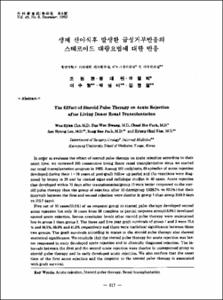생체 신이식후 발생한 급성거부반응의 스테로이드 대량요법에 대한 반응
- Alternative Author(s)
- Cho, Won Hyun; Park, Choal Hee; Park, Sung Bae; Kim, Hyun Chul
- Journal Title
- 대한외과학회지
- ISSN
- 1226-0053
- Issued Date
- 1993
- Abstract
- In order to evaluate the effect of steroid pulse therapy on acute rejection according to their onset time, we reviewed 200 consecutive living donor renal transplantation since we started our renal transplantation program in 1982. Among 200 recipients, 69 episodes of acute rejection developed during their 1 ~ 10 years of post-graft follow up period and the rejections were diagnosed by biopsy in 29 and by clinical signs and radiologic studies in 40 cases. Acute rejection that developed within 30 days after transplantation (group 1) were better responsed to the steroid pulse therapy than the group of rejection after 30 days(group 2)(89.7% vs 80.0%) but their intervals between the first and second rejection were shorter in group 1 than group 2(49.9 days vs 155.7 days).
Five out of 10 cases(50.0%) of no response group to steroid pulse therapy developed second acute rejection but only 10 cases from 59 complete or partial response group(16.9%) developed second acute rejection. Serum creatinine levels after steroid pulse therapy were maintained low in group 1 than group 2. The three and five year graft survivals of group 1 and 2 were 76.4 % and 68.5%, 65.9% and 41.5% respectively and there were statistical significance between these two groups. The graft survivals according to status to the steroid pulse therapy also showed statistical significance. We conclude that the steroid pulse therapy for acute rejection was better responsed in early developed acute rejection and in clinically diagnosed rejection. The intervals between the first and the second acute rejection were shorter in unresponsed group to steroid pulse therapy and in early developed acute rejection. We also confirm that the onset time of the first acute rejection and the response to the steroid pulse therapy is associated with graft survival.
생체 신이식후 발생한 급성거부반응이 스테로이드 대량요법에 어느정도 반응을 하고 또 거부반응이 발생한 시기가 스테로이드 요법에 대한 반응정도와 관계가 있는지를 알아보기 위해 1982년 11월부터 1991년 12월까지 계명대학교 등산의료원 신이식팀에서 시행한 200예의 신이식 환자중 급성거부반응으로 진단된 69 예를 분석하여 다음과 같은 결과를 얻었다. 급성거부 반응의 발생시기는 39예가 30일이내(제 1 군)였고 30 예가 30일이후(제2군)였으며 이들의 스테로이드 대량 요법에 대한 반응정도는 제1군이 89.7%,제2군이 80.0%로서 거부반응발생시기가 빠를수록 스테로이드 대량요법에 대한 반응정도는 높게 나타났다. 또 진단 방법별로는 임상소견 및 방사선소견으로 진단한 40예 의 스테로이드 치료에 대한 반응율(92.5%)이 조직검 사로 확인된 29예의 반응율 75.9%보다 높았고 이는 급성거부반응의 특징적인 소견을 나타내어 진단이 용이했던 군이 스테로이드치료에 더 잘 반응하는 것으로 생각되었다. 첫번 거부반응후 같은 환자에서 두번째 급성거부반응을 일으켜 조직검사로 확진된 예가 15예 있었는데 이들의 두 거부반응간의 기간은 첫 거부반응 발생시기가 빠른 군에서 그리고 스테로이드치료에 반 응치 않은 군에서 짧았다. 첫 거부반응의 발생시기에 따른 이식신의 생존율은 제 1 군이 제 2 군에 비해 높았 고 통계적 유의성도 나타내었다. 또 스테로이드치료에대한 반응정도와 이식신 생존율간에도 통계적 유의성이 있었다.
이상의 결과로서 급성거부반응은 이식후 30일 이내 의 조기에 발생한 군이 그 이후에 발생한 군보다 스테로이드 치료에 잘 반응했으며, 스테로이드치료에 반응 했던 군일수록 두번째 급성거부반응이 을 확율은 떨어 지고,두번째 거부반응까지의 기간은 길어졌다. 또 첫 번 거부반응의 시기가 빠를수록 두번째 거부반응까지 의 기간은 빨라짐을 알 수 있었다. 그리고 첫번 거부 반응의 시기와 거부반응시 스테로이드 대량요법에 대한 반응정도가 이식신의 생존율과 관계가 있음을 보여 주었다.
- Alternative Title
- The Effect of Steroid Pulse Therapy on Acute Rejection after Living Donor Renal Transplantation
- Publisher
- School of Medicine
- Citation
- 조원현 et al. (1993). 생체 신이식후 발생한 급성거부반응의 스테로이드 대량요법에 대한 반응. 대한외과학회지, 45(6), 817–826.
- Type
- Article
- ISSN
- 1226-0053
- 파일 목록
-
-
Download
 oak-bbb-02944.pdf
기타 데이터 / 539.51 kB / Adobe PDF
oak-bbb-02944.pdf
기타 데이터 / 539.51 kB / Adobe PDF
-
Items in Repository are protected by copyright, with all rights reserved, unless otherwise indicated.